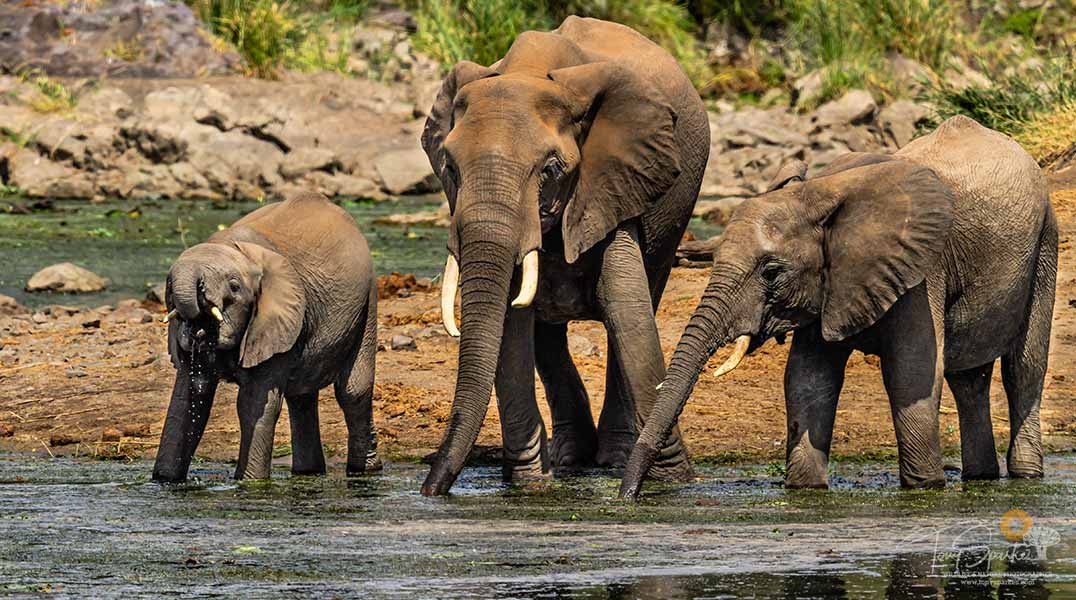Safari Animals
Big 5 Safari Animals
The big five large safari animals of Southern Africa. How did these five safari animals the Lion, Elephant, Buffalo, Rhinoceros and Leopard come to be called the Big Five? It was originally a hunting term used by the so-called ‘Great White Hunters’ in the hunting heyday of the 19th and early 20th centuries when professional hunters bagged as many trophies as possible in as short a time as possible.
It was considered a rite of passage for seasoned travellers, everybody from American presidents to European royalty and heads of state came to Africa to shoot a large dangerous animal the ‘Big Five’ quickly became known as the most dangerous animals to hunt on foot.
Big Five of Africa
The name stuck, although today shooting is done through a camera lens generally, although several African countries still sell permits to hunt and shoot Africa’s Big 5.
African Cape Buffalo (Syncerus caffer)
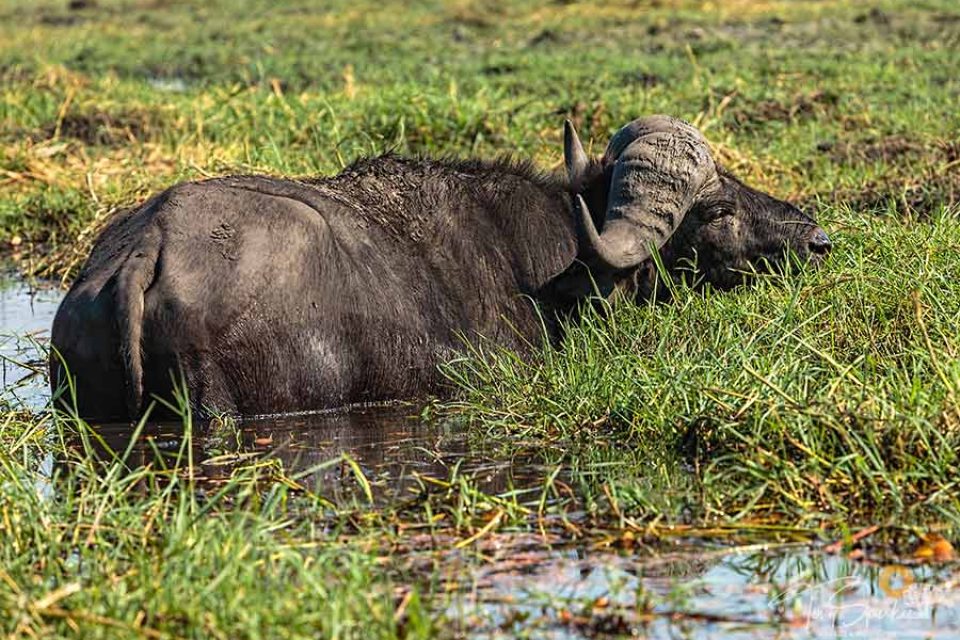
The African buffalo is a large African bovine. African or Cape Buffalo are herbivore’s and are not closely related to the slightly larger wild Asian water buffalo (Bubalus bubalis ) with its African ancestry remaining unclear. Therefore Cape Buffalo as we know it today has evolved from a smaller ancestor that came into African 6 million years ago.
This Safari Animals Distinguishing Features
The adult buffalo’s horns are its characteristic feature, it has a fused base forming a continues bone shield, referred to as a ‘Boss’. It is widely regarded as a very dangerous animal which kills over 200 people each year.
Buffalo have a lifespan of roughly 23 years; they are ‘ranked’ in their herds by their fighting capabilities. Buffalo will often have head on clashed to determine rank in the herd. The hide on the buffalo’s neck can be a few inches thick to protect it during battles with other male bulls for dominance. Dominant individuals will feed ahead of the rest of the herd or in the middle and gets the best nutrient rich grass and best access to females in oestrus.
Buffalo are gregarious and live in mixed herds often numbering hundreds of individuals. They are not territorial because they are bulk grazers and need to find suitable grazing and water on an ongoing basis. Buffalo consume very coarse material and can consume 35 litres of water at a time in just a matter of minutes.
Habits
A Buffalo has an excellent sense of smell and can use this sense to find food or detect danger and predators nearby. These incredible animals can also swim and will cross rivers into areas better suited for grazing.
Other than humans African Buffaloes have few predators aside from lions and can defend themselves. Being a member of the ‘Big Five’ game family, the Cape Buffalo is a sought-after ‘trophy’ in hunting. Buffalo are reported to kill more hunters in Africa than any other animal. These safari animals are known to ‘ambush’ hunters that have wounded or injured them
African Animals Facts – African Cape Buffalo
- Member of the Big 5 (Yes)
- Female Gestation:340 days
- Lifespan: 15-20 Years
- Group: Herd
- Size: 300-900kg
- Diet: Herbivore
- Number of young: 1 possibly 2 but rare
Where Cape Buffalo can found in Africa
- Kruger National Park (South Africa)
- Chobe National Park (Botswana)
- Queen Elizabeth National Park (Uganda)
African Leopard (Panthera p.pardus)
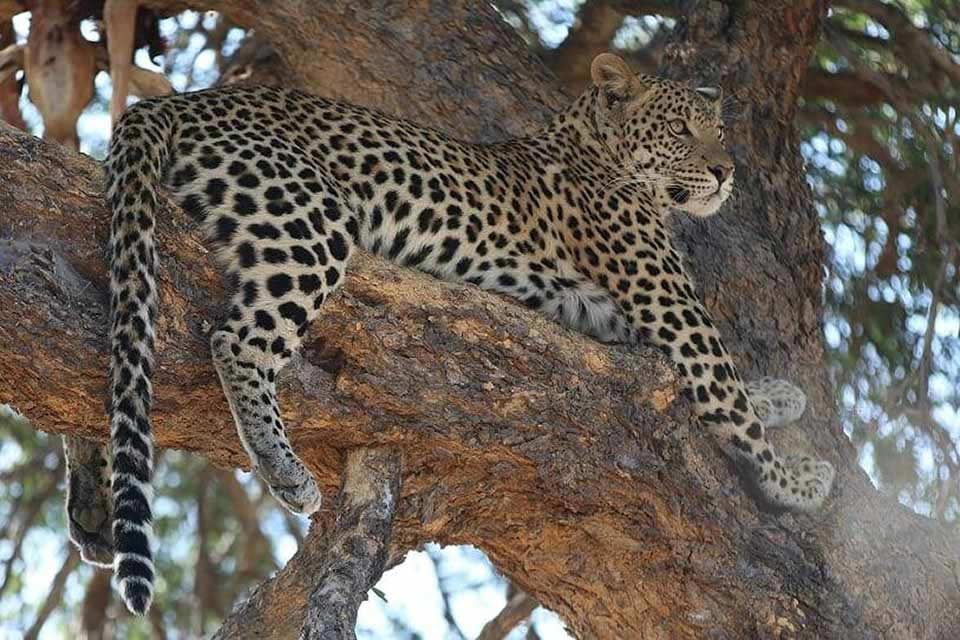
The African Leopard is one of the five big cats and very territorial. The leopard has relatively short legs and a long body with a large tail having numerous functions including showcasing its mood, used as communication, displaying irritation, used in mating rituals and movements (climbing and balancing). Leopard are skilled tree climbers with an ability to adapt to various habitats ranging from rain forest to arid areas and able to run at speeds of up to 58 km/h (36 miles per hour)
This Safari Animals Distinguishing Features
This safari animal is similar in appearance to the Jaguar but is smaller and more lightly built. Leopards fur is marked with rosettes like those of the Jaguar, but the Leopards rosettes are smaller and more densely packed and do not usually have central spots as the Jaguars do. The pattern on each animal is much like a fingerprint on a human; every leopard has their own distinct set of markings.
Leopards are probably one of the most secretive and elusive animals in the animal kingdom. Leopards are generally nocturnal with high adaptability. A leopard’s vision at night is 7 times that of a human and hearing is 5 times better than that of a human.
The leopard success in the wild is no doubt due to its well camouflaged, opportunistic hunting behaviour raw diet and incredible strength to move heavy carcasses (its prey) into trees. Despite their size leopards can hoist almost their own body weight (their prey) into trees where they seek refuge from Lions and Hyena. Leopards do not need that much water and may survive on the moisture from their prey.
African Animals Facts – African Leopard
- Member of the Big 5 (Yes)
- Female Gestation: 90-115 days
- Lifespan: 10-15 Years
- Group: Solitary
- Size: 30-80kg
- Diet: Carnivore
- Number of young: 2-6 (But high mortality rate)
Where Leopard can found in Africa
- Murchison Falls National Park (Uganda)
- Sabi Sand Game Reserve (South Africa)
- Serengeti National Park (Tanzania)
Rhinoceros (Black & White)
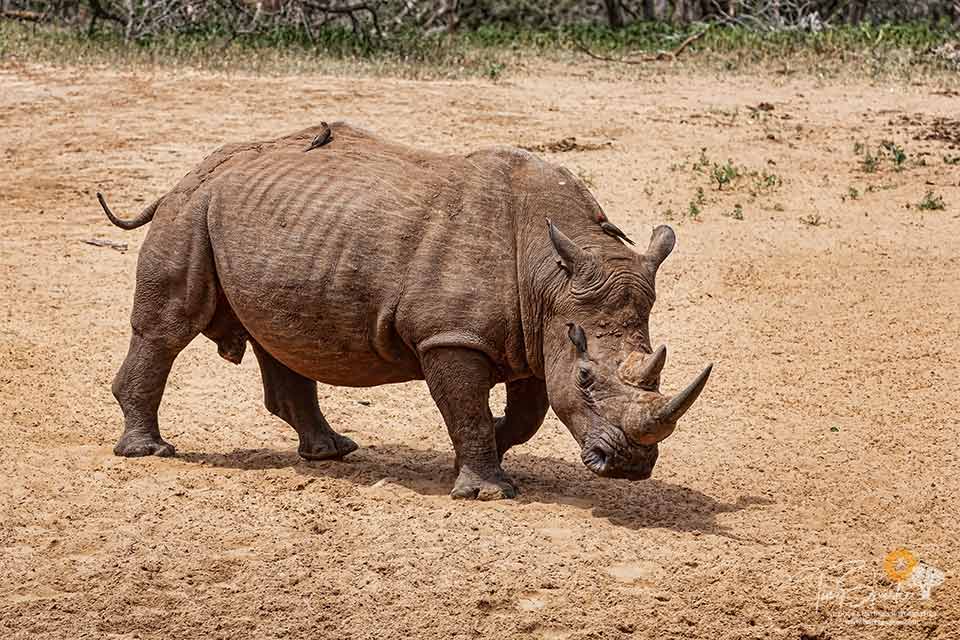
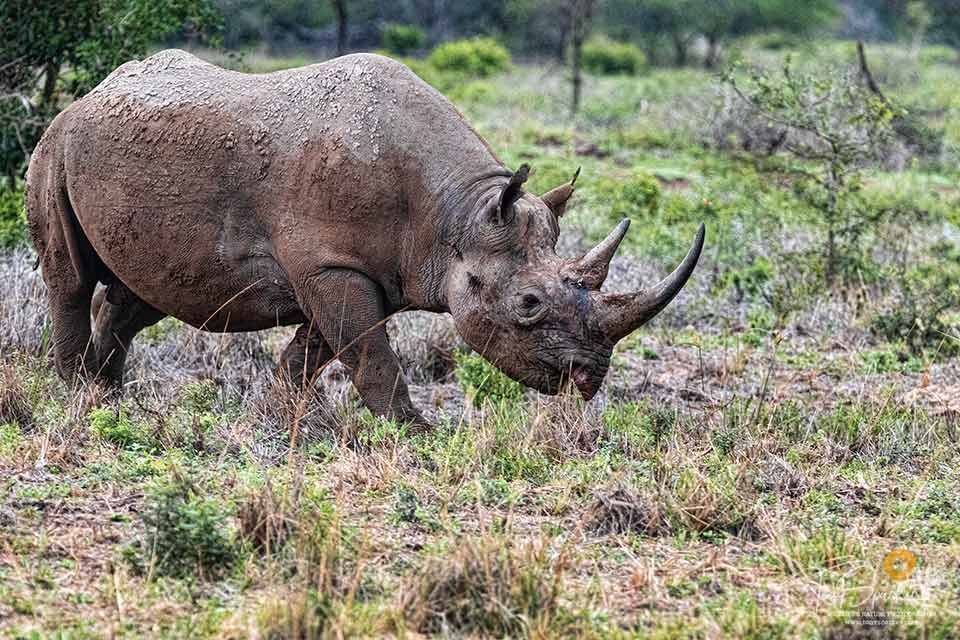
There are two Rhinoceros species in Africa, the larger White Rhinoceros or Square Lipped Rhinoceros and the slightly smaller Black Rhinoceros (Diceros Bicornis). The White Rhinoceros can be broken further into 2 sub-species, the southern white rhinoceros (Ceratotherium simum simum) and the northern white rhinoceros (Ceratotherium simum cottoni). Unfortunately, the Northern White Rhinoceros is very close to becoming extinct and will not be seen in the wild.
Rhinoceros that are native to Africa are characterised by their large size. Both species of the large safari animals are herbivorous (non-meat eaters) and can reach one tonne or more in weight. Both of these safari animals have protective skin of 1.5 – 25 centimetres thick and have relatively small brains for mammals of this size some 400 to 600 grams.
Poaching
Rhinoceros are generally characterised by their large horns which are bought and sold on the black market. Both the White and Black rhinos today face similar threats of rampant poaching, driven by an insatiable demand for rhino horn from Far East countries such as Vietnam and China.
The horns are generally used for ornamental or traditional medicinal purposes. By weight, rhino horns cost as much as gold on the black market. Greed has unfortunately led to a great decline in these animals numbers over the past century. Astronomical prices for horns on the black market has seen these animals’ numbers drop from an estimated 600, 000 in the 1900’s to a mere 4,800-5,000 remaining today in around 38 officially protected areas in Africa.
This Safari Animals Distinguishing Features
The Black rhino is slightly smaller but considered more aggressive and territorial than the White Rhino. However, the White rhino can be almost double the weight of the Black Rhino at around 6000 lbs or nearly 2800 kg. The Black Rhino is not black though, more a grey tone, similarly, the white rhino is not white but also a grey tone.
Generally, the Black Rhino are browsers, while White Rhino is a grazer. ‘Browsers’’ take leaves, bark, and green stems from plants, while ‘Grazers’ take vegetation at or near to the ground level like a cow. This is clearly characterised by the two rhinos different mouth shapes, there most distinguishing feature in the field.
The Black Rhino has a mobile mouth which ends in a sharp pointed upper lip, used for browsing leaves. While the White Rhino mouth is wide and flat designed for mowing and grazing grass.
African Animals Facts – Rhinoceros
- Member of the Big 5 (Yes)
- Female Gestation: 16 months
- Lifespan: 35-50 Years
- Group: Solitary
- Size: 900 -2800 kg
- Diet: Herbivore
- Number of young: 1 calf
Where Rhinoceros can be found in Africa
- Hluhluwe-Umfolozi Park (South Africa)
- Moremi Game Reserve ( Botswana)
- Lewa Wildlife Conservancy (Kenya)
African Elephant (Loxodonta africana)
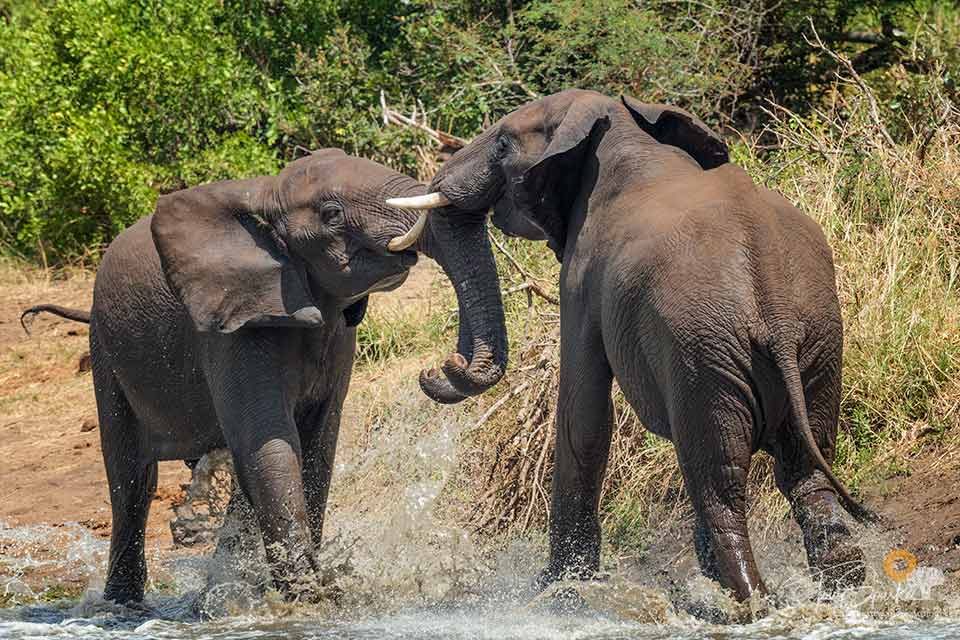
This Safari Animals Distinguishing Features
Elephants are large mammals. There are two species which are traditionally recognised in Africa. The African Elephant (Loxodonta) is a genus comprising of two living elephant species, the African bush elephant (Loxodonta africana) and the smaller African forest elephant (Loxodonta cyclotis) found in the more humid forests in West Africa and the Congo Basin. It is more than likely you will encounter the African Bush Elephant on most African safari’s so we will discuss this species only here.
African Bush Elephant (Loxodonta africana)
African bush elephants are located throughout sub-Saharan Africa. African elephants are the largest extant terrestrial animals and can reach heights of 4 meters or 13 ft. These huge beasts can weigh as much as 7,000 kg or 15,000 pounds.
Teeth and Eating
Elephants are large safari animals and herbivores (non-meat eaters) and may spend up to 18 a day merely eating. Elephants eat between 150 and 170 kilograms of food per day. Their incisors (teeth) grow into tusks at around 350 mm or 7 in every year, these tusks can also serve as weapons and as tools for moving objects. It is also said that Elephants prefer one tusk from the other, just like humans being left or right-handed
Trunks and Ears
All elephants have several distinctive features the most notable of which is its long trunk. or proboscis which is used for many purposes, particularly breathing, drinking water which is between 140 -230 litres or 37- 61 gallons a day. Trunks are also used for sensing size, shape and temperature. It’s also useful for grasping objects as it has over 40 000 muscles in it. Elephants have very large ears that flap and help to cool the body down when warm. by radiating heat from blood vessels.
Musth
Male bull elephants go through a periodic condition called Musth. It is characterised by a ‘discharge’ of a thick tar-like secretion from temporal ducts on the sides of the head. Bulls also become. highly aggressive in behaviour and have a large rise in reproductive hormones.
Testosterone levels in an elephant in Musth can be on average 60 times greater than in the same elephant at other times. Scientific investigation of Musth is problematic because even the most placid elephants become highly violent toward humans and other elephants during Musth. If you come across a African bull Elephant in Musth be very very careful with one’s approach, its sensible and a better idea to leave well alone.
Threatened
The African Elephant is listed as a vulnerable species as listed on the IUCN redlist. Mainly due to habitat loss, farming and poaching
African Animals Facts – African Bush Elephant
- Member of the Big 5 (Yes)
- Female Gestation: 22 months
- Lifespan: 60-70 Years
- Group: Herds (Large males bulls age 12-15 years usually solitary or in small groups)
- Size: 3000 -7000 kg (F&M)
- Diet: Herbivore
- Number of young: 1 calf normally, very occasionally 2
Where Elephants can be found in Africa
- Addo Elephant Park (South Africa)
- Amboseli National Park (Kenya)
- Chobe National Park (Botswana)
Lion (Panthera leo)
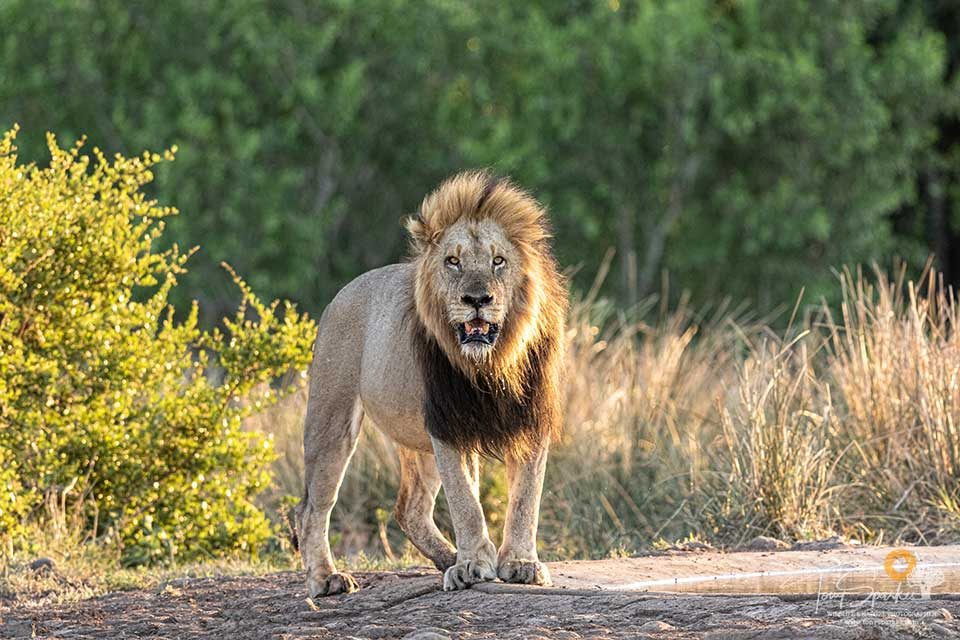
The lion is the king of the big cats with some males exceeding 250 kilograms (550 lbs) in weight. Lions are the second largest living cat after the tiger. Wild lions currently exist in sub Saharan Africa and in Asia. The lion is a vulnerable species having seen a major population decline in its African range of 30 to 50 percent for two decades during the second half of the 20th century. Although the cause of the decline is not fully understood habitat loss and conflicts with humans are currently the greatest causes of concern Within Africa the West African lion population is particularly endangered.
This Safari Animals Distinguishing Features
Lions are social and live in groups called a pride. A pride can have up to 3 males and the rest will be females and their young with female lions living together for life. Lions are unusually social compared to other cats the pride size will depend on the availability of food and water.
Lions have significant roars; a lion’s roar may be heard up to 8 km (5 miles) miles away and can be nearly as loud as thunder. Lions begin to vocalise as soon as they are born but their vocalisations don’t start to develop into roars until lions are about one year old. Roaring allows lions to claim their territory by communicating their presence to potential intruders, it also helps them communicate with fellow lions within their pride. Lions typically inhabit savannah grassland, although they can be found in bush and forest habitats.
The Pride
A pride of lions consists of related females and offspring together with a small number of adult males. A prides territory can extend as far as 260 square kilometres. It is the male’s that will protect this territory. In the wild males seldom live longer than 10 to 14 years as injuries sustained from continual fighting with rival males greatly reduced their longevity. In captivity they can live more than 20 years.
Lions require many calories. Lions typically consume 4.5 kg to 11 kg (10 to 25 lbs) of meat daily. Lions are opportunist hunters, and, after a careful stalk, will take the closest animal regardless of its age, sex or condition. Males are responsible for the security of the pride; they participate in hunting. Females are primarily responsible for hunting which typically takes place after dark.
This king of the jungle gets some serious shuteye. Male Lions sleep on average 20 hours a day. While the female Lions get 15 to 18 hours sleep a day on average.
African Animals Facts – Lions
- Member of the Big 5 (Yes)
- Female Gestation: 110 Days (3 and a half months)
- Lifespan: 10-14 Years (In the wild)
- Group: Social Pride
- Size: 180 -250 kg (F&M)
- Diet: Carnivore
- Number of young: 2-4 Cubs
Where Lions can be found in Africa
- Kruger National Park (South Africa)
- Hwange National Park (Zimbabwe)
- Serengeti National Park ( Tanzania)
Conclusion
When you talk about an African safari today one always imagines seeing the sight of Africa’s Big 5 large safari animals. Whether you have been on a safari before or going for your very first safari there is nothing like experiencing your encounter with a big cat, that roar of a lion or being close to the worlds largest land mammal. Its something to certainly get the adrenaline pumping and the cameras clicking to capture those treasured moments.
African Big Five Safaris
I lead and host several Big 5 safaris in Southern and South Africa. My wildlife safaris and photo safaris are hosted in some of the world’s premier Big 5 game reserves, which include safaris in the Kruger Park and our ‘Big Cat’ photo safari in the Sabi Sand game reserve. It would be a pleasure to see you on one of our wildlife tours.
- African Wildlife Photography Tips - February 23, 2020
- Low Light Wildlife Photography - November 26, 2019
- Bonamanzi Game Reserve - November 21, 2019

